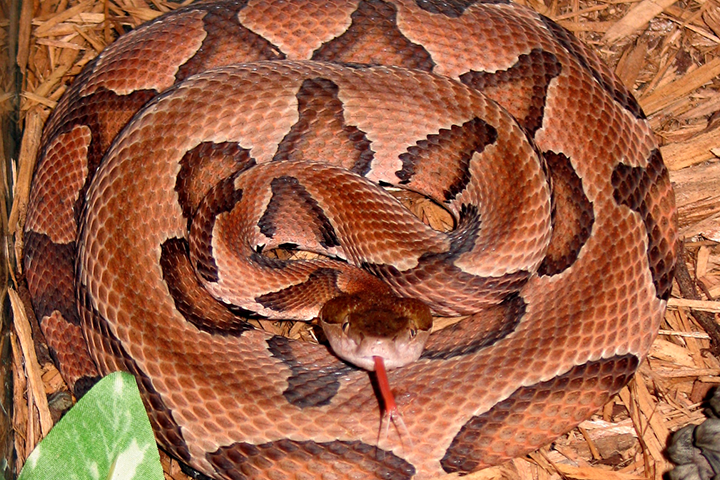
In the Southeastern United States, one of the biggest fears of homeowners and people who work or play outside is venomous snakes like copperheads. Copperheads are a serious concern, but you should know other non-venomous and beneficial species of snakes are often misidentified as copperheads and killed.
In this blog, our snake control professionals will explain how to tell if it’s a copperhead snake or the harmless northern banded water snake. Both look similar, but they have some key differences.
Copperheads in the Southeastern United States
Copperhead snakes are part of the pit viper family and are classified as venomous snakes. They are also in the genus Agkistrodone, which includes the cottonmouth or water moccasin species.
Here are some important things to know about copperheads:
- Like most venomous snakes, copperheads have a triangle-shaped head
- Known to be fairly aggressive and typically give no warning signs before striking. If they feel threatened by a human or animal, they will strike.
- They typically bite more people in a year than any other snake. However, their venom isn’t as potent as other species.
- While getting bit will no doubt hurt, the bite usually isn’t fatal.
Need a Wildlife Control Estimate?
Click below to leave your information and we will call you right back!
Get your free estimate today!
Leave your information below and we will give you a call back.
After-hours inquiries will be returned the next business day.
Water Snakes in the Southeastern United States
The North Georgia water snakes that people often come across are the Banded and Northern species. These snakes have bands that are wide on the top and look borderline symmetrical, while the Copperhead’s pattern and band are narrow on top and look more like an hourglass. That can sometimes be hard to spot, so taking a few extra moments to get a good look can often help you pick out these key differentiating factors. There are other species of water snakes in the Southeastern United States, like the brown water snake. In that species, their bands don’t connect or wrap all the way around. Instead, they are broken or split across the top. Water snakes in North Georgia have a head that is in line with their body and more narrow, straight, and slightly rounded.
A quick way to tell if a species is a water snake is that water snakes do not swim high on the water, and their head is not elevated when they swim. Copperheads will very rarely go in the water, but they are typically found elsewhere. When water snakes are threatened while swimming, they will almost always try to get away by diving underneath the water.
Snake Removal Services in the Southeastern United States
If you see snakes in or around your home, contact Lookout Pest Control as soon as possible. We can identify whether or not the snake is venomous, the best way to remove it, and how to prevent snakes from entering your property in the future. You can trust us to provide you with the most efficient and professional snake removal services in the trial.
Ready to get started? Call us today!
Back to Wildlife ControlBeware Of Copperheads and Water Snakes This Summer in Tennessee, Georgia, Alabama, Kentucky, North Carolina, & South Carolina
Serving the Southeastern United States
Tennessee | Chattanooga Metro | Nashville Metro | Knoxville Metro
| Georgia | Atlanta Metro |
Alabama | Huntsville Metro | Birmingham Metro
Kentucky | Bowling Green Metro | Hopkinsville | Russellville
| North Carolina | Charlotte Metro |
South Carolina | Charleston Metro
Home » Wildlife Control » Beware Of Copperheads and Water Snakes This Summer
